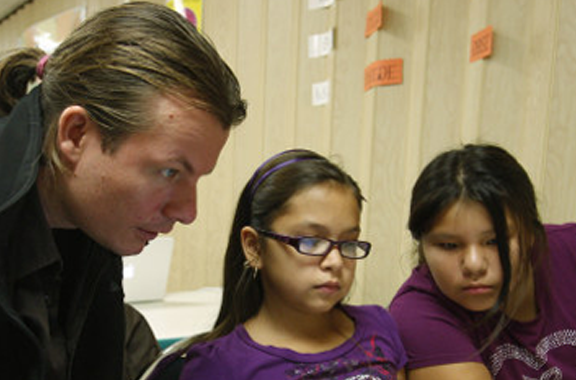Photograph; In this file photo taken Monday, Oct. 25, 2010, Joseph Erb, helps out students Cambria Bird, left, and Lauren Grayson, right, in the fifth grade class of the Cherokee Nation Immersion School in Tahlequah, Okla. | AP
As the public at-large expresses their distress for what is the name of a basketball, basketball, or football team, a worthy conversation, the deeper wounds remain. Naked in the wind are the untreated scars that tear the soul. Poverty and the effects of that searing pain cut to the core. Our youth suffer. The scars last long into adulthood. Yet, rather than attend to these, Americans go to games and argue about team names. What about those faceless children whose monikers we never learn and whose is learning hindered. We will ever look upon their longing faces and forget the games, political and professionally played?
How The Federal Government Is Hurting Native American Students
As Congress squabbles over ending the federal government shutdown, Jim Gross, the superintendent of Selfridge Public School District #8 in North Dakota, looks on in skepticism.
He grew up on Standing Rock Indian Reservation, where he was adopted by the local Sioux tribe, and moved back there 21 years ago because he wanted to “do good things for the Native kids.” But the weak economy, which drove the reservation into an ever-deepening state of poverty, and the federal sequestration cuts and 16-day-old government shutdown, are making it hard for him to do his job.
“Back then, politics was people getting together, something would come out about it if you sit down,” he said. “Both sides have gotten so far to the extreme, the radical stage. Our families say, well, okay, here’s the government again. They’re not doing anything again.”
Schools that serve students who live on Native American reservations and military bases generally don’t have the same level of property taxes that fund most public schools, so they get a special federal funding stream known as Impact Aid. The aid is not provided in advance, as is most federal education aid, so schools that receive it were among the first to feel the blows of sequestration cuts. As the new fiscal year began in October, these schools also saw a reduction in other federal program appropriations because of the sequester.
And now, the government shutdown has left them in a cloud of financial uncertainty. The Senate reached an agreement to end the shutdown on Wednesday morning, but if it doesn’t pass, some schools could run out of the money they need to operate.
Gross said he has frozen most updates that were scheduled for old school buildings in his district and cut back on professional development training for teachers. With 26 employees for the district’s 100 students, he said he couldn’t cut any teachers in good conscience. “There’s no place for us to cut and still teach the classes we need,” he said. “That’s what really bothers me.”
Traditionally, districts like Selfridge ask the federal government to dispense Impact Aid early to help them make payroll. This year, several districts — including Shannon County School District #65-1 in South Dakota, Nepselem School District #14 in Washington, Central Kitsap School District in Washington and Sierra Sands Unified School District in California — made that request.
But none of them have heard back. According to Cameron French, a spokesman for U.S. Secretary of Education Arne Duncan, the federal Education Department cannot process these requests during the shutdown.
Gross sent his letter in October. “Ever since the shutdown, we’ve gotten nothing,” he said. “We depend on that money out here. What really concerns me is they’re looking at the two most vulnerable groups of kids: our Native kids, and our military kids. They get hit the hardest.”
He said his district has so far lost $100,000 due to sequestration — that’s about $1,000 per student. Those cuts are somewhat offset by funding from the state of North Dakota, flush of late with oil money. But the effects of cuts pile up, and the district’s reserve funds could only sustain the district for four or five months. “Families see this and say, ‘They’re not working for us,'” he said, referring to the government.
Out of a sample of 45 schools that receive Impact Aid, 31 have cut positions, eight have cut professional development, 10 have reduced transportation, and 12 anticipate closing programs, according to a survey conducted by the National Association of Federally Impacted Schools about the 2013-14 academic year.
South Dakota’s Shannon County, which has 1,500 students, sent the feds an early funding request twice — once in September, then once in October, said Coy Sasse, the district’s business manager. “Not getting that funding would exacerbate any kinds of cash flow issues that we have,” he said. Impact Aid pays for 30 to 35 percent of the district’s budget. So far, the district has cut back on construction projects, programs, staff and travel.
“Any time you have uncertainty at that federal level with an organization that relies too heavily on federal funding, it makes it difficult to plan,” Sasse said. “We’re potentially not seeing our Impact Aid money for four to six more months, if at all — that’s a huge issue for us. We do have some cash reserves but not enough to sustain us for a lengthy period of time. At that point when the cash reserve runs out, we’d have to start continuing to go through that budget reduction process until we couldn’t do that anymore.”
David McVicker, the assistant superintendent for Central Kitsap School District in Washington, also sent an advanced funding request in September, and said he didn’t hear back. The district serves the Kitsap Navy Base and has 10,000 students, about half of whom are connected to the military. It had already reduced its budget by $15 million before sequestration because of the recession. The district currently has a balance of $6 million, but McVicker said it’s expected to be under $2 million in January.
McVicker has worked in the district for 27 years. He said he’s saddened to see financial troubles affect schools’ ability to educate students: class sizes have crept up, and he has lost more 40 teaching positions out of 600.
“We’re just looking at a slow death if this continues,” he said.












Leave A Comment